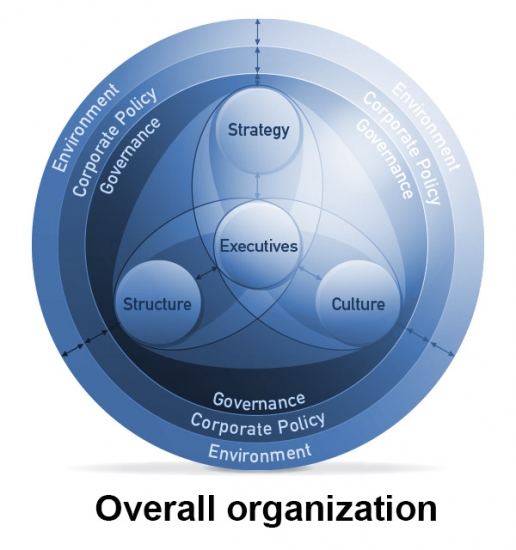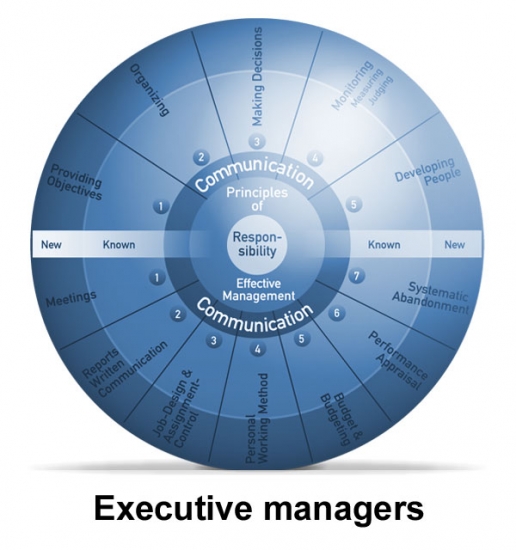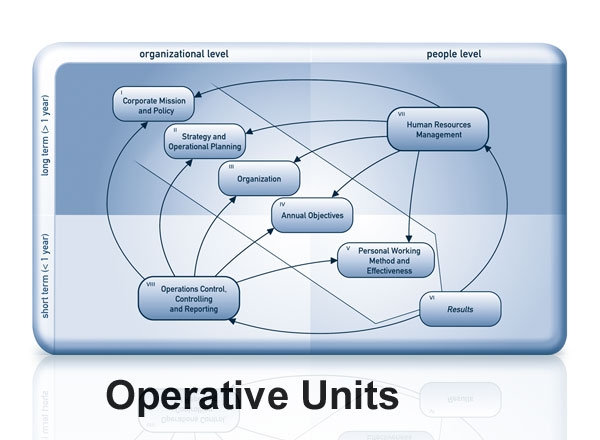The Malik Management Basic Models
Malik’s basic models for wholistic management are extensive solutions for most management problems and strengthen the manageability of organizations many times over. They revolutionize in particular the ability to effectively overcome change and the ability to transform measures into results. These models help to establish the necessary conditions for system-inherent coordination and coherence by way of self-regulation and self-organization within the very capillaries of an organization.
The inner core of the Malik ManagementSystems® is formed by three basic models that contain everything needed for Right and Good Management so as to enable organizations to function and people to be successful.
Management of institutions: The Malik General Management Model®
At the overall institution level, the General Management Model is used to assist management. This model contains the sub-systems needed for the overall management of institutions of any type and any size. The term “institution” encompasses all types of organizations. All components are interconnected and join to form a single whole. At the same time, they are embedded in the sub-systems of Corporate Governance and Corporate Policy, which in turn are themselves embedded in the environment and form the interface to this. This way of thinking and approach to seeing and understanding management opens the path for managers to become correctly understood generalists while also retaining their special knowledge that is just as necessary. This approach to modeling organizational and control functions, forwhich we use the all-encompassing term ‘management’, but which also includes governance and leadership, enables mistake-free guidance and navigation, regardless of the degree of complexity
Management for persons – The Malik Standard Model of Managerial Effectiveness®
At the level of the individual and the team, the Malik Standard Model of Managerial Effectiveness® is the standard tool. In German, this model has quickly come to be known as the “management wheel”. It contains all necessary and adequate components of professional effectiveness, namely the principles, tasks and tools needed to effective action and the necessary communication and responsibility. In the book Managing Performing Living, the standard model of managerial effectiveness is described in detail.
The Malik Integrated Management System IMS®
The result of the combination of the General Management Model and the standard model of managerial effectiveness into a new general model is the “Malik Integrated Management System – IMS®”. It is the model for managing people in institutions, comprising the entire organization. The IMS comprises all the system components necessary and sufficient for the functioning of an organization, and comprises two dimensions: The first is time, i.e. the present and future, on the vertical axis; the second is content, referring to both the organization as a whole and the individuals in it, on the horizontal axis. With its corporate strategy, the top management of an organization answers the question: Where are we headed? Inputs to strategy are the company purpose and its mission, which answer the question: Who are we?
Even these few basic models for holistic management provide comprehensive solutions for most management problems, enhancing organizations’ manageability by several orders of magnitude. Above all, they revolutionize the ability to master change effectively, as well as the power to transform actions into results. As these systems are applied further down the organizational periphery, on an adequate scale and at adequate levels, their effects multiply. No more endless meetings, no more tiresome discussion about innumerable details. These models create the conditions for system-immanent coordination and coherence through self-regulation and self-organization, down to the capillaries of an organization.


